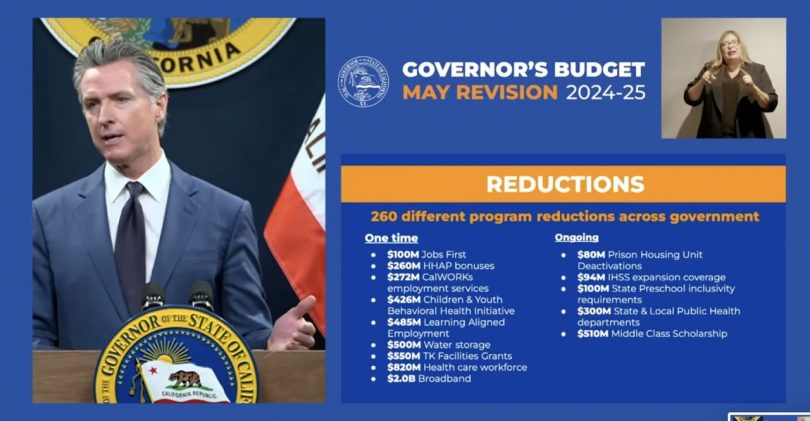Faced with a budget deficit of approximately $56 billion over the next two years, California Governor Gavin Newsom has proposed, in his May budget revision, significant cuts to spending on homelessness prevention programs and affordable housing, CalWORKS, child care, education, public health, and climate programs. The governor stressed that he was filling the budget gaps without “proposing new taxes on hardworking Californians and small businesses.”
Yet, many of the governor’s proposed cuts for the next two fiscal years will negatively impact Californians who are low-income, unhoused, or at risk of losing their homes, according to advocacy groups, including the League of California Cities.
“The Governor’s proposal will hurt those already most vulnerable in our communities: the unhoused, those who are one paycheck, eviction, or natural disaster away from homelessness, and those struggling to find safe and affordable housing,” the LCC wrote in response to Newsom’s budget.
One area justice system reform advocates say is ripe for deeper cuts is the state’s $14.5 billion in prison system spending.
Governor Newsom’s current budget draft prescribes an $80 million cut to be achieved by closing 46 housing blocks in 13 state prisons.
There are a handful of other small cuts to the California Department of Corrections and Rehabilitation, including to the fire camp program, guard training, and COVID-19 testing, but the $80 million in housing block closures is by far the largest cut in the prison system category.
A 2023 report from the state’s Legislative Analyst’s Office estimated that the state could save $1 billion by closing five prisons.
“Deactivation of whole prisons is generally more cost‑effective than similarly sized capacity reductions achieved through yard deactivations,” the LAO wrote.
The state could save yet more money by eliminating “unnecessary prison infrastructure costs.”
The LAO pointed to the state’s construction of a $31 million healthcare facility at California Correctional Center just a year before the prison was shuttered.
During his first year in office, in 2019, Newsom declared a moratorium on the death penalty. Under Newsom’s leadership, in the years since, the state has closed three prisons with one more closure in progress expected to be completed in 2025.
Newsom has been resistant to closing additional prisons, however. Part of the issue is that the state must stay under a federal court-mandated prison population cap of 137.5 percent capacity.
This shouldn’t be a problem, according to the Legislative Analyst’s report, which notes that the long-term decline in the state prison population will likely result in 20,000 empty prison beds (approximately 20 percent of the state’s prison capacity). “This means that the state could be in a position to deactivate around five additional prisons by 2027, while still remaining roughly 2,500 people below the federal court‑ordered population limit,” the report states.
With this in mind, the criminal legal reform group Californians United for a Responsible Budget (CURB) has launched a petition to put pressure on the governor to close 5 prisons, starting with the California Rehabilitation Center in Norco (CRC), a costly and dilapidated prison in Riverside County.
In 2012, then-Governor Jerry Brown had planned to close CRC by 2016. Because of those plans, during the budget process that year, the state legislature chose to spend $810 million constructing prison housing elsewhere. However, Norco was ultimately left operational to ease overcrowding — to help the state comply with the federal court’s mandate.
CURB also received concerning reports about conditions in CRC through a survey of more than 2,000 incarcerated people in California.
“Without air conditioning, summer temperatures exceed 100 degrees F, with only 5 fans for 100 people,” one anonymous respondent wrote in the CURB survey.
“Closing entire prisons, starting with a prison like the California Rehabilitation Center in Norco (CRC), is a sensible step towards significant cost savings,” said CURB’s executive director, Amber-Rose Howard. “These funds should be redirected to offset the shameful cuts to education, housing, and other programs that would better address the root causes of criminalization, like poverty, and support communities across California.”


Ahhhhh. This is where we need to be able to share GIFs in our comments. This deserves the best laugh GIF out there.
Tradition Of Service – ✔️ 🙂